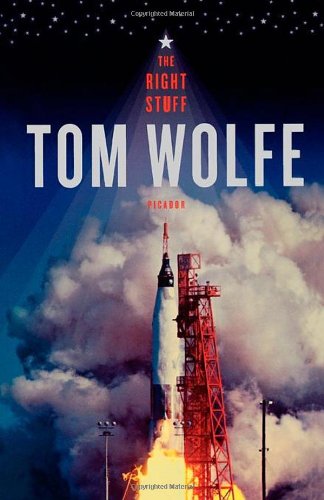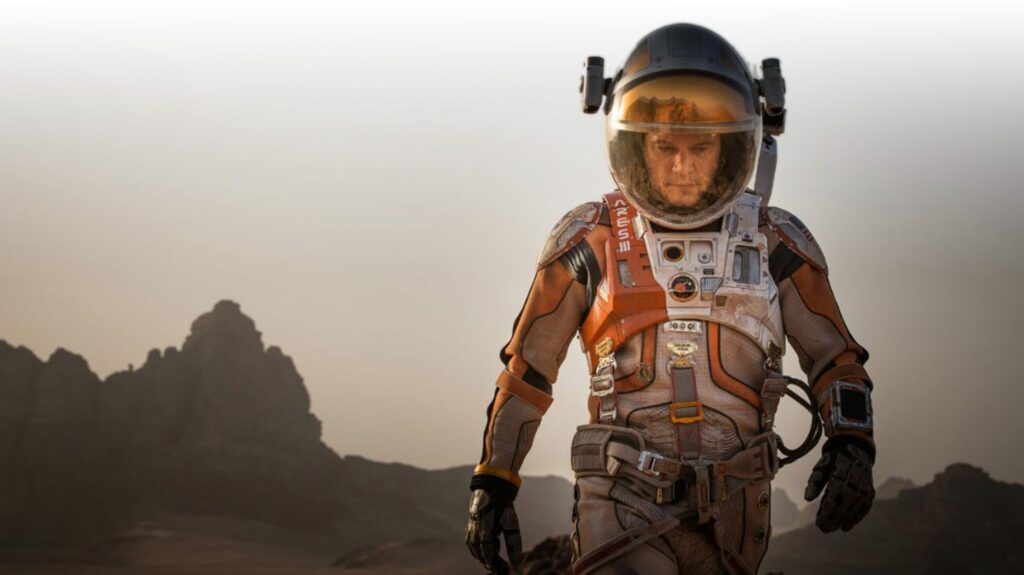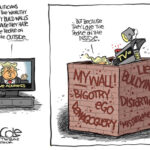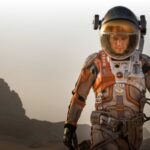BY THE SEATTLE TIMES
All this reporting and writing about the moon landing’s 50th anniversary got us in the mood to read and watch some science fiction. So here are our staffers’ picks for some of their favorite astronaut-themed science fiction books, movies and TV shows. We narrowed it down to selections grounded in science and space travel. (Thus, the exclusion of “Star Wars.”)
Here goes, sorted by media type in order of release year.
Books — fiction
“Binti: The Complete Trilogy” by Nnedi Okorafor (DAW, Feb. 5). When Binti becomes the first of the Himba people to join the ranks of students at the prestigious Oomza University in space, she leaves Earth behind and finds herself thrown into the center of a generations-long war between the university and an alien race known as the Meduse. This three-book series follows Binti and her unlikely allies as she balances the culture she came from and the future she represents. — Crystal Paul
“The Calculating Stars” by Mary Robinette Kowal (Tor Books, July 3, 2018). An alternate-history novel set in the early ‘50s. The premise? A giant meteorite smashes into Washington, D.C., in 1952 and accelerates the need for humans to find another planet to live on. Dr. Elma York is a World War II veteran who flew planes as a WASP. She also happens to be a math genius and one of NASA’s human computers, and she decides she wants to be an astronaut. The novel explores what might have happened if women were allowed in the astronaut corps early in the space race, and it also touches on the civil-rights movement and struggles faced by African Americans in that time period. — Stefanie Loh
“The Fated Sky” by Mary Robinette Kowal (Tor Books, Aug. 21, 2018). In this sequel to “The Calculating Stars,” mankind has managed to reach the moon and has now set its sights on establishing a human colony on Mars — in 1961. Dr. Elma York — otherwise known as “The Lady Astronaut” — is hoping to get chosen for the Mars mission, but torn between her professional ambitions and her personal life. Once again, Kowal does not fail to pull in the social environment of the early ‘60s, and the tensions resulting from the civil-rights movement and South Africa’s apartheid are woven into the narrative. — Stefanie Loh
“The Wanderers” by Meg Howrey (G.P. Putnam’s Sons, March 14, 2017). This is character-driven literary science fiction at its finest and it examines how humans will deal with the challenges of long missions of space exploration. “The Wanderers” follows three astronauts through a 17-month training simulation for a Mars mission and through them gets at the question of what drives humanity’s need to explore. But the narrative also pulls in the families of the astronauts and we see the strain that the long separation puts on them. — Stefanie Loh
“Seveneves” by Neal Stephenson (William Morrow, May 19, 2015). What would we do if we knew the world was about to be destroyed by “hard rain” that will fall for 5,000 years? That’s the premise of this science-fiction saga by a Seattle novelist who’s one of the masters of the genre. As Seattle Times reviewer Nisi Shawl wrote in 2015, “Stephenson’s storytelling style combines the conversational and the panoramic, allowing him to turn his piercing gaze on the familiar aspects of a strange future, encompassing the barely conceivable detail by detail, striking vista by sweat-covered heroic gambit, and telling us how it might be possible to regain what we could so easily lose in so many heartbreaking ways.” — Stefanie Loh
“The Three-Body Problem” series by Cixin Liu (Tor Books, English translation of first book published November 2014). President Barack Obama called it “just wildly imaginative, really interesting.” Amazon reportedly may spend up to $1 billion acquiring the rights to produce a three-season TV show based on the Hugo Award-winning series. There’s a reason the first installment in this trilogy was the first Asian novel ever to win a Hugo Award. The series, based in China, chronicles the existential crisis that grips all of humanity when it encounters an extraterrestrial civilization bent on taking over Earth. But the alien armada won’t arrive for another 400 years, leaving humans plenty of time to bicker over how best to prepare the eventual space battle. — Neal Morton
“The Expanse” series by James S.A. Corey (Orbit, first book published June 2, 2011). This eight-novel series also inspired a TV series. First novel is “Leviathan Wakes.” My whole family loves both books and TV shows for realistic depictions of working and traveling in space. The summary: In a world in which humanity has colonized most of the solar system, tensions build between Earth, Mars and the outer planets, and then alien tech comes into the picture. — Carole McClosky
“Stories of Your Life and Others” by Ted Chiang (Vintage, July 5, 2002). “Stories of Your Life” was adapted to the big screen as the movie “Arrival,” featuring a fearless Amy Adams as Dr. Louise Banks, a linguist charged with finding a way to communicate with Earth’s new alien arrivals. But this isn’t your everyday alien encounter story. It incorporates sophisticated concepts of physics, language and time, and wrestles with the idea of free will. — Crystal Paul

SUBMITTED PHOTO
Tom Wolfe’s book, “The Right Stuff”
Books — nonfiction
“Packing for Mars: The Curious Science of Life in the Void” by Mary Roach (W.W. Norton & Co., April 4, 2011). Mary Roach is the queen of taking scientific subjects and turning them into witty, hilarious prose. In “Packing for Mars,” she puts everyday questions in the context of space travel and what it would take to get astronauts to Mars. This means you get a series of delightful essays centered around questions like “What happens when an astronaut pukes in his helmet?” Roach shows you how space food evolved to what it is today, writes about the Zero G toilet in entertaining detail and takes you behind the scenes to see how Japan selects astronauts. — Stefanie Loh
“Right Stuff, Wrong Sex: America’s First Women in Space Program” by Margaret A. Weitekamp (Johns Hopkins University Press, Dec. 9, 2005). The public faces of the Apollo program were male astronauts, but that’s not because women weren’t qualified for space travel. In fact, the doctor in charge of stress-testing the test pilots who became the first astronauts was convinced women might be especially well-suited to the job, and invited women pilots to undergo the same tests as their male counterparts. Alas, the program was not sanctioned by NASA, and the women never went into space. Written by Margaret Weitekamp, curator of the National Air and Space Museum’s social and cultural dimensions of spaceflight collection in Washington, D.C., “Right Stuff, Wrong Time” delves into this chapter of women’s history in America for a glimpse into what might have been. — Megan Burbank
“Moondust: In Search of the Men Who Fell to Earth” by Andrew Smith (Harper Perennial, second edition, July 2). Originally published in 2005, this was written by a British journalist who decided in 1999 — 30 years after the first moon landing — to track down all nine of the remaining living (at the time) astronauts who had walked on the moon to find out what they did with the rest of their lives. Essentially, to try to answer the question of whether there’s any way to find fulfillment again on Earth after walking on the moon. As might be expected, the answers were different for each man, but for all of them, life was never again the same. — Bob Condotta
“The Right Stuff” by Tom Wolfe (Farrar, Straus & Giroux, May 16, 2004). Though much of the action precedes the Apollo program proper, Tom Wolfe’s account of the lives of naval test pilots who would become America’s first astronauts is a fun romp and one of the definitive stories of how space travel in America came to be. Not all of it holds up — there’s a lot of unexamined mythmaking around the pilots’ performative masculine swagger (see: “Flying & Drinking and Drinking & Driving,” women referred to as “cookies”) but it’ll make you fall in love with Chuck Yeager, it takes into account the experiences of the long-suffering women who were married to test pilots, and Wolfe’s description of what happens to a plane “at the edge of space” is alone worth the price of admission — “the ordinary laws of aerodynamics no longer applied and a plane could skid into a flat spin like a cereal bowl on a waxed Formica counter.” It’s impossible not to want to know what happens next. — Megan Burbank
Movies
“Apollo 11” (2019). “Apollo 11” is one of the best documentaries about the space program I’ve ever seen. Released in 2019, it consists solely of archival footage — on 70mm no less — of the mission’s various stages from launch to touchdown, plus on-the-ground video of the folks camped out to see the rocket blaze into the sky. With a subtly thrilling score, masterful editing and no talking heads or hand-holding narration, it unfolds more like an exciting feature film than a dry historical account, and short of sitting in front of a living-room TV on July 16, 1969, it may be the closest thing we have to a real-time look at the moon landing. — Megan Burbank
“Hidden Figures” (2016). A rousing, inspiring crowd-pleaser, this fact-based 2016 Oscar nominee shone a light on a trio of heroines: three brilliant black women who worked as “computers” in the early days of the space program, a workplace dominated by white men. — Moira Macdonald
“The Martian” (2015). Whip-smart astronaut played by Matt Damon uses his science-based skills to save his life on the Red Planet after being accidentally stranded there. — Soren Andersen
“Interstellar” (2014). A Christopher Nolan masterpiece featuring Matthew McConaughey, Anne Hathaway and Jessica Chastain as astronauts who travel through a wormhole to search for a home for humanity. It’s weird, complex and all about relativity. And I loved every second of it. — Stefanie Loh
“Afronauts” (2014). True story: In 1964, Zambian science teacher Edward Makuka launched his own space program to try to beat the U.S. to the moon. He formulated a dubious plan to launch 16-year-old Matha Mwambwa into space using an aluminum rocket and a catapult system. The rocket never took off, but decades later director Frances Bodomo’s short film takes a look at what the Zambian space program might have looked like. — Crystal Paul
“Gravity” (2013). Astronauts (Sandra Bullock and George Clooney) try to rescue themselves after their space shuttle suffers catastrophic damage. — Soren Andersen
“Another Earth” (2011). A thought-provoking film on second chances and forgiveness that follows a young and intelligent woman whose one mistake leads her to deal with the consequences of her choice and the choices she continues to make afterward. While the film largely ignores the scientific and physical impacts of having another Earth — such as gravity and the atmosphere — the second Earth in the film adds a layer of mystery and uneasiness to the story. — Amanda Snyder
“Sunshine” (2007). Director Danny Boyle’s visually gorgeous, contemplative drama about a crew of astronauts dispatched on a mission to try to reignite the dying sun. — Soren Andersen
“Space Cowboys” (2000). Senior-citizen astronauts (Clint Eastwood, James Garner, Donald Sutherland and Tommy Lee Jones) prove to NASA that age is no barrier when it comes to space travel. — Soren Andersen
“Contact” (1997). Robert Zemeckis is a hit-or-miss director if there ever was one, but his adaptation of the Carl Sagan novel “Contact” is one of his triumphs. Starring Jodie Foster as a woman of science and Matthew McConaughey as a man of faith, “Contact” is the kind of space-travel movie that’s about so much more: love, death, science, religion and the nature of reality, all in a warmly cerebral movie that privileges character development over spectacle. — Megan Burbank
“Gattaca” (1997). Featuring one of Ethan Hawke’s most underrated performances and prescient details about DNA testing, 1997’s “Gattaca” is more than just a movie you probably saw in your high-school biology class during senior week. With coolly minimalist design and cinematography and Uma Thurman and Jude Law doing the most in key supporting roles, it’s a story of thwarted ambition and the planetary loneliness of space travel, sibling rivalry and conformity, with old Hollywood-style glamour, Patricia Highsmith-esque intrigue, and a wonderfully ‘90s vision of a dystopian future. — Megan Burbank
“Apollo 13” (1995). In all the celebration this year over Apollo 11’s successful moon landing, we’d be remiss if we didn’t also mention this classic space movie starring Tom Hanks, that immortalized the words, “Houston, we have a problem” and tells the story of Apollo 13’s ill-fated mission to the moon in April 1970. — Stefanie Loh
“The Right Stuff” (1984). It doesn’t get better than Sam Shepard as Chuck Yeager — that’s a man’s man. Mr. Cool. It’s three hours long, but so well done. — Rich Boudet
“Outland” (1981). A space Western retelling of “High Noon” with Sean Connery in the Gary Cooper role. — David Miller
“Silent Running” (1972). About a post-apocalyptic space station (a floating garden in space — like a biodome) run by the last remaining (and injured) crew member (Bruce Dern) and his cadre of little robots. — David Miller
“2001: A Space Odyssey” (1968). Stanley Kubrick’s masterpiece about astronauts imperiled by the rogue robot HAL 9000 on a mission to Jupiter. — Soren Andersen

WARNER BROS. PICTURES / MCT
Sandra Bullock and George Clooney star in “Gravity.”
TV
“Star Trek: Discovery” (2017-present). The original “Star Trek” was born during the space race, and the canon has grown over the last half century. This newest series debuted on CBS All Access in 2017, and it’s set about a decade before the original “Star Trek” series, and follows the adventures of Commander Michael Burnham and the crew of the USS Discovery. — Stefanie Loh
“Mars” (2016-present). The National Geographic miniseries is an intriguing mix of documentary and science-fiction drama. It blends the fictional story arc of a group of astronauts landing on Mars with documentary-style interviews with scientists and big names like Elon Musk, Neil deGrasse Tyson and author Andy Weird to discuss what it would take to get to and set up a human colony on Mars. It’s based on Stephen Petranek’s 2015 book “How We’ll Live on Mars.” — Stefanie Loh
“The Expanse” (2015-present). TV series based on novels by James S.A. Corey. Alien technology discovered and misused by baaaad humans upends our solar system, where conflicts were already bubbling among Earth, colonized Mars and the colonized outer planets (including asteroid belt). Gripping stuff, very realistic. Three seasons done by Syfy Channel; Amazon took it over in Season 4. — Carole McClosky
“Battlestar Galactica” (2004-09). With an incredible cast, acting and writing, the show explored the fuzzy line between human and cyborg, the roots of religion, the rise of political movements, and questions of what constitutes terrorism and what tactics are justified to combat it. The cast was well balanced between women and men, and not in a token-ish kind of way. The staging was brilliant in avoiding the claustrophobic, monotonous ship-board look of many other space shows. — Sandi Doughton
“Firefly” (2002-03). “Firefly” is basically director Joss Whedon’s take on cowboys in space. A ragtag group of misfits take to the stars in an old spaceship to make a dime by taking on contracts, bounties and fares, but naturally find a great deal of trouble along the way. You won’t find a lot of science in this series, but the storytelling and the charming cast of characters is hard to beat. — Crystal Paul

Caitlin Heaney West is the content editor for Access NEPA and oversees the Early Access blog in addition to working as a copy editor and staff writer for The Times-Tribune. An award-winning journalist, she is a summa cum laude graduate of Shippensburg University and also earned a master’s degree from Marywood University. Caitlin joined the Times-Shamrock family in 2009 and lives in Scranton. Contact: cwest@timesshamrock.com; 570-348-9100 x5107; or @cheaneywest




